
The Morgan Library & Museum, New York
16 June – 1 October 2023
by LILLY WEI
During his lifetime, Ferdinand Hodler was a venerated artist, his stature comparable to that of Rodin and Monet, but, unlike them, he was largely forgotten after his death except in his native Switzerland. Since the 1970s, there have been several attempts to restore him to the pantheon of late-19th- and early 20th-century painters, his work dusted off and re-examined for its contributions to modernism and influence on artists such as Edvard Munch, Egon Schiele, and Oskar Kokoschka, who are shown with regularity. It is therefore a treat to see his work at the Morgan Library & Museum, especially since the focus is on his rarely shown drawings, an exhibition conceived and overseen by Isabelle Dervaux, the Morgan’s curator and head of modern and contemporary drawings, in collaboration with the Musée Jenisch Vevey. Surveying more than three decades of his practice, the 60 or so works on view are a small but illuminating selection from the Rudolf Schindler cache of works by Hodler (mostly on paper) that was donated to the Swiss museum.
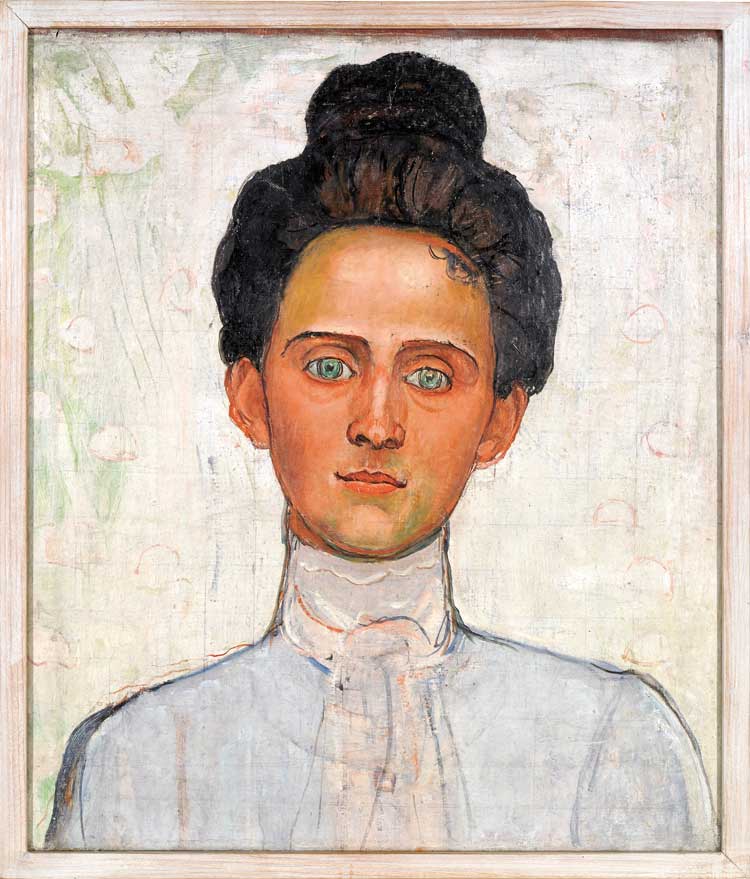
Ferdinand Hodler. Portrait of Berthe Hodler-Jacques c1898. Musée Jenisch Vevey, Donation Rudolf Schindler. © Musée Jenisch Vevey.
Hodler was a brilliant draughtsman who made thousands upon thousands of compositional sketches, figure studies and full-scale details in preparation for his commissions, as well as incessantly jotting down thoughts and images in notebooks, the exhibiting of such materials increasingly common as interest in the details of an artist’s process has gripped more general audiences. It is like accessing a diary, a glimpse into the real time of creation, as if the artist were present. (The Morgan’s Bridget Riley show, just across the hall, also depends on the artist’s drawings and notes and is equally engrossing and enlightening.)
Hodler was born in Berne in 1853 and died in Geneva in 1918. He was raised in a financially pressed working-class family of 12 children and, showing talent, trained as a commercial artist. At 18, he made his way (on foot) to Geneva to try his luck. There, and elsewhere, he haunted museums, copying from the works of the masters. He also studied with professional artists; one mentor of particular importance was Barthélemy Menn (a student of Ingres), whom Hodler worshipped. It was Menn, he said, who taught him to revere the line that he honed into a sinuously expressive beauty that would make him famous.
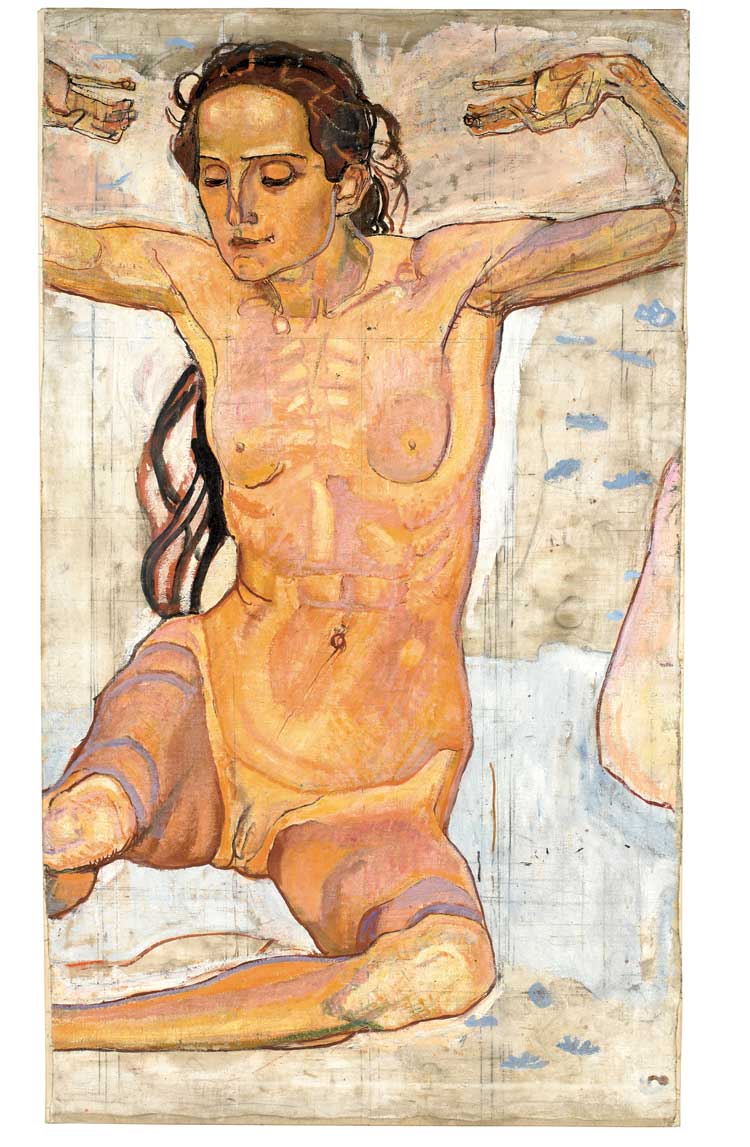
Ferdinand Hodler. Study for Day (fragment), 1899 Musée Jenisch Vevey, Donation Rudolf Schindler. © Musée Jenisch Vevey. Photo: Claude Bornand Lausanne.
His earlier subjects centred on death (before adulthood, he had lost his parents and immediate siblings one after the other to tuberculosis) as well as the despair and precarity of a life lived at the margins but, by the beginning of the 1890s, he had made his breakthrough, internationally acclaimed as a history painter and the restorer of the tradition of monumental murals as well as an allegorist championed by Rodin and the pre-eminent French symbolist Pierre Puvis de Chavannes. The Night (1889-90), considered indecent when first shown in Geneva, was received enthusiastically in Paris, and later paired with The Day in a characteristic balancing of opposites. Always obsessively reworking his compositions, Hodler made several versions of Day from 1899-1910, accompanied by drawings and oil studies of beautifully delineated figures, some of which are shown here.
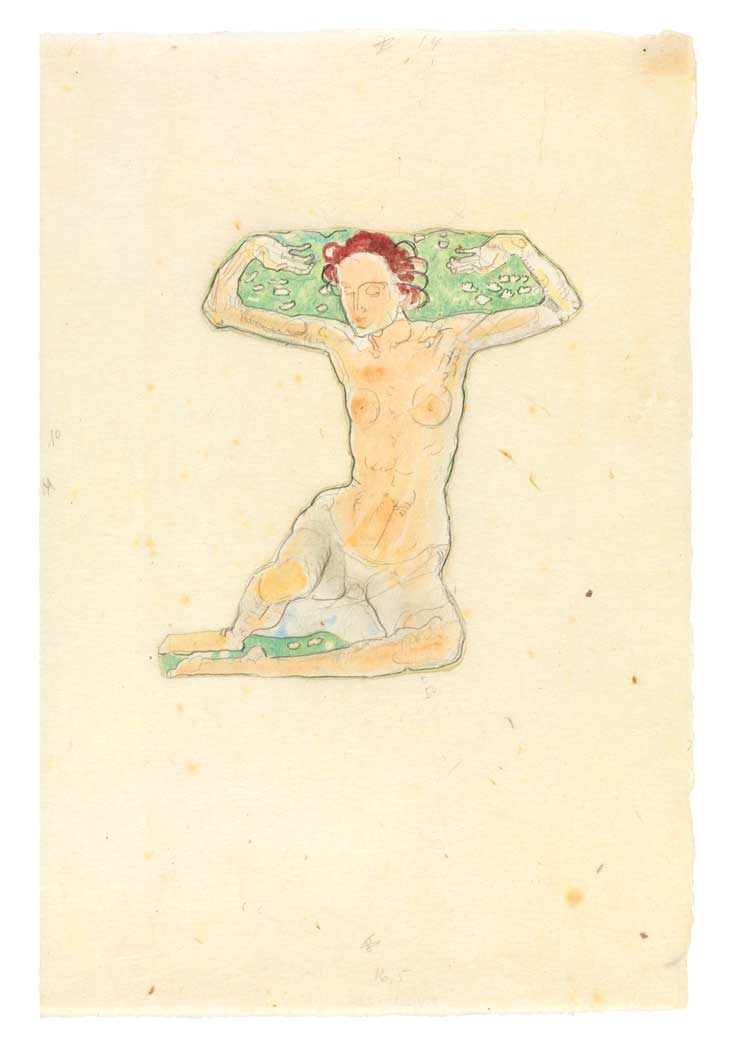
Ferdinand Hodler. Figure Study for Day, c1899-1900. Musée Jenisch Vevey, Donation Rudolf Schindler. © Musée Jenisch Vevey.
His last such work to be completed was the majestic View into Infinity (1916), the five statuesque, over-life-sized women gowned in blue stretched out across the surface like a line of dancers, arms gracefully akimbo, hands reaching towards each other, the evolution of the painting – including the shift from an elliptical arrangement – represented here by several sketches from 1910-13.
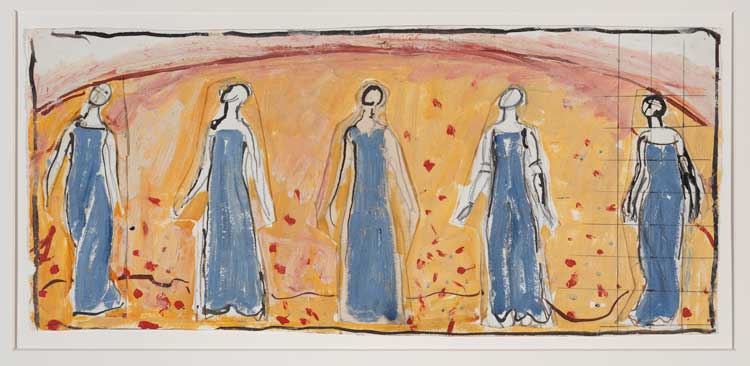
Ferdinand Hodler. Compositional Study for View into Infinity, 1910-13. Musée Jenisch Vevey, Rudolf Schindler bequest. © Musée Jenisch Vevey, Julien Gremaud.
His acutely observed, elegantly limned genre scenes depicting women and children, on the other hand, were lighter in tone, more upbeat, increasingly so as the 90s advanced, his former bitterness and suffering no doubt assuaged by the turn in his fortunes.
Compositional sketches jumpstarted his ventures. He begins with a few lines, “a shorthand of ideas”, as he called them, and proceeds from there to more elaborate explorations, resolutions, the quickness of the drawing giving them an arresting immediacy and animation in contrast to his more formal, completed paintings. In constructing his pictures, he often uses a drawing frame, also called a Dürer pane (a clear sheet of glass slotted into a wood frame – Dervaux’s explanation of how Hodler used the device can be found in her excellent catalogue essay).
Hodler also developed a theory called parallelism, based on repetition and symmetry that he believed reflected the order of nature which, in turn, was reflected in the order of society, embodied in his frieze-like compositions, which evoke the ritual processions of classical antiquity or Egyptian tomb paintings.

Ferdinand Hodler. Compositional Study for Departure of the German Students for the War of Liberation of 1813, 1907-08. Musée Jenisch Vevey, Donation Rudolf Schindler. © Musée Jenisch Vevey.
Examples here are the preparatory sketches for three of his best known war murals that include The Departure of the German Students for the War of Liberation of 1813 (1907-08), a sequence that shows us how he simplified the composition to make the narrative clearer, tighter and more dramatic, shifting the positions of the figures and their poses, reducing their number – in one drawing, we see a lone figure of a fallen soldier where before there were several, foregrounding the truth that we die alone. He also divided the composition into two tiers, the top a stylised, repetitive file of resolute marching soldiers that sets the pace, while the lower tier’s figuration and poses are more varied, if also symmetrical. He also insisted on historical accuracy, such as in the soldier’s dress and weapons, another of his innovations.
Hodler, not surprisingly, was also enthralled by the mountainous terrain of his homeland, as in The Eiger, the Mönch and the Jungfrau above a Sea of Fog (1908), an oil painting of three of the major peaks of the Bernese alps envisioned as triangles of white beneath a solid blue sky. He had painted these kinds of scenes for tourists as a teenager, but had transformed them beyond mere mementos and, while several landscape studies are included, he mostly painted them directly on to the canvas, en plein air. Hodler’s solid version of a romantic landscape is a far less soulful vision of the sublime, but equally riveting, and summons its own thoughts about the mysteries of nature that lie at the heart of existence.
Another category in which he excelled was portraiture, captured with meticulous, sensuous, detail, his human sitters subjected to the same scrutiny as his objects. They are so meticulous that the personalities and inner thoughts and feelings of the subject seem to be pulled to the surface, revealed through countless observations. His many self-portraits are equally sensitive, unsparing, some genial, his eyes lively, alert, some not, such as a sketch from the last year of his life, face worn, his expression apprehensive, perhaps sorrowful, as if asking an unvoiced question.
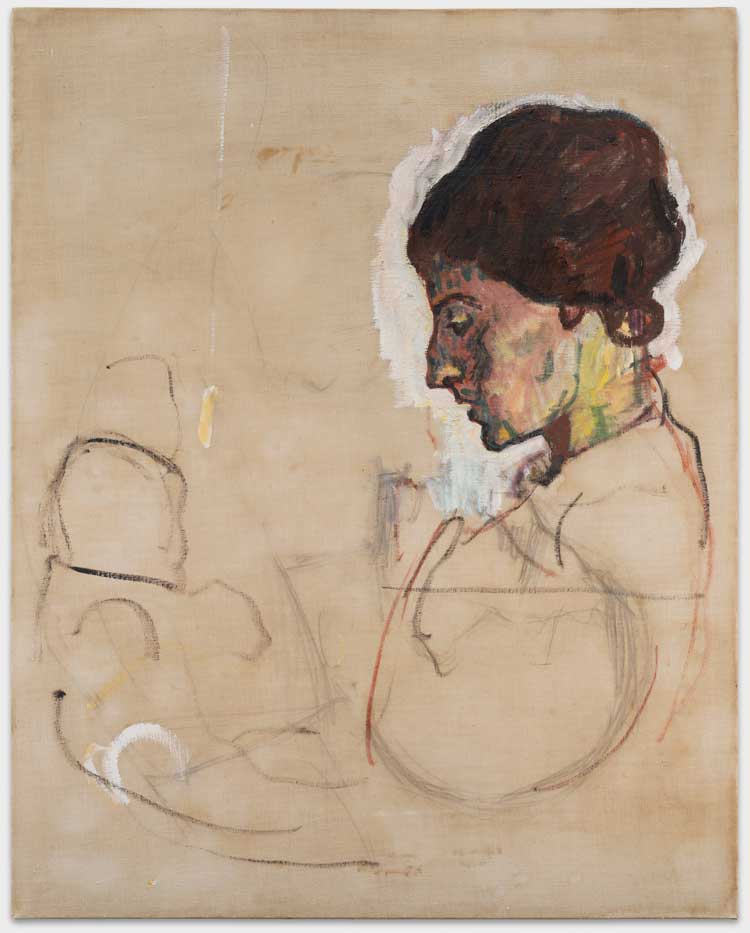
Ferdinand Hodler. Unfinished Portrait of Valentine Godé-Darel and her Daughter Paulette, 1914. Musée Jenisch Vevey, Donation Rudolf Schindler. © Musée Jenisch Vevey.
The emotional heart of the exhibition, however, was the poignant, unprecedented series of drawings of Valentine Godé-Darel, his model, who later became his mistress, with whom he had a daughter, born in 1913. Godé-Darel was diagnosed with cancer soon after she gave birth, and Hodler made the drawings over the course of her illness, sitting by her bedside, drawing her most often in profile (although there is one where her face is touchingly, unsettlingly turned toward us) with clinical precision, each dated; she died in January 1915. As the disease ravaged her, he said that for some, it was only then that their true beauty was revealed. They also made me think of Hannah Wilke’s unflinching last photographs of herself, taken as she was dying of cancer. I can’t help wondering what Hodler thought as he made them; they were so private I wanted to avert my eyes. Was it a reproach to fate? Was it a challenge – art in battle with reality? An antidote to death? Was it another instance of the male gaze, no matter how stricken?
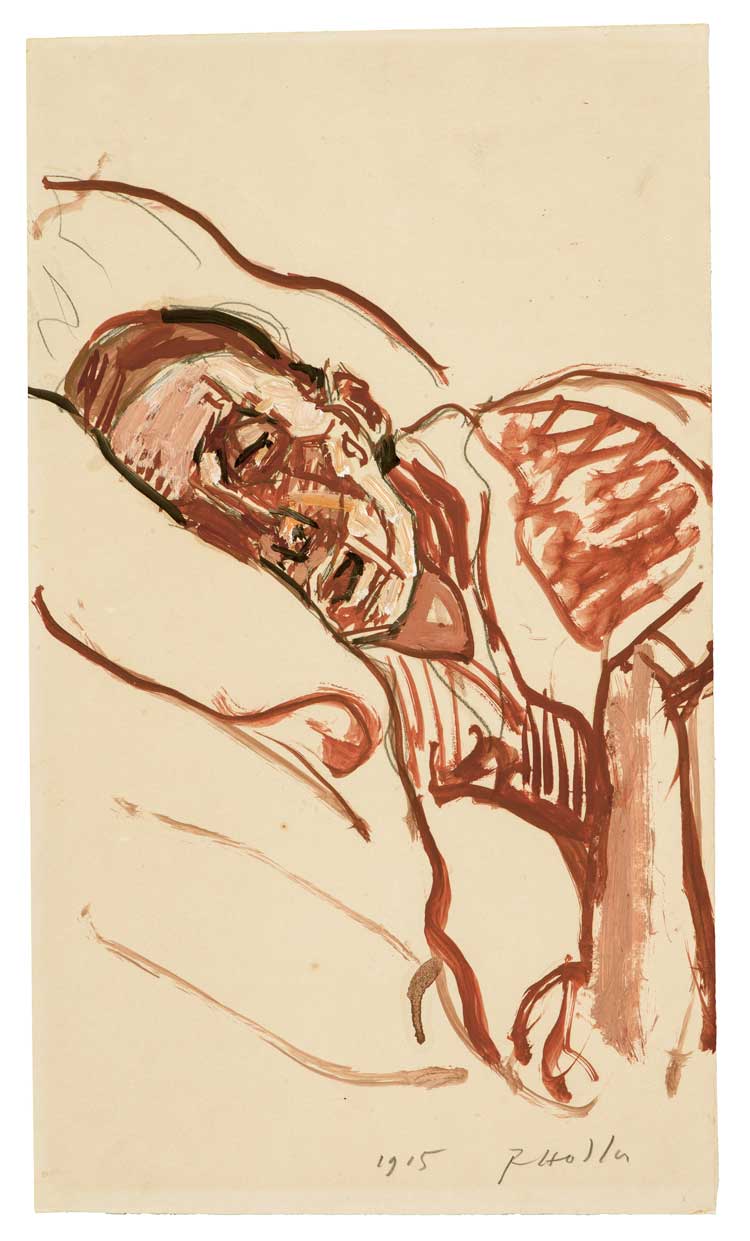
Ferdinand Hodler. Portrait of Valentine Godé-Darel Dying, January 1915. Musée Jenisch Vevey, Donation Rudolf Schindler. © Musée Jenisch Vevey.
Be that as it may, this exhibition is a superbly lucid reintroduction to a major artist who needs to be restored to his rightful place in art history and a new generation of viewers. Alternating between the allegorical and the empirical, was he a symbolist, a realist, or an expressionist? In fact, he was all three, it seems, and in our more permeable, less categorically imperative times, he is all the more relevant for it.
Through film, sound and dance, Emma Critchley’s continuing investigative project takes audiences o...
Rijksakademie Open Studios: Nora Aurrekoetxea, AYO and Eniwaye Oluwaseyi
At the Rijksakademie’s annual Open Studios event during Amsterdam Art Week, we spoke to three arti...
AYO – interview: Rijksakademie Open Studios
AYO reflects on her upbringing and ancestry in Uganda from her current position as a resident of the...
Eniwaye Oluwaseyi – interview: Rijksakademie Open Studios
Eniwaye Oluwaseyi paints figures, including himself, friends and members of his family, within compo...
Nora Aurrekoetxea – interview: Rijksakademie Open Studios
Nora Aurrekoetxea focuses on her home in Amsterdam, disorienting domestic architecture to ask us to ...
Kiki Smith – interview: ‘Artists are always trying to reveal themselve...
Known for her tapestries, body parts and folkloric motifs, Kiki Smith talks about meaning, process, ...
Frank Auerbach, Britain’s greatest postwar painter, has a belated German homecoming, which capture...
How Painting Happens (and why it matters) – book review
Martin Gayford’s engrossing book is a goldmine of quotes, anecdotes and insights, from why Van Gog...
Jonathan Baldock – interview: ‘Weird is a word that’s often used to...
As a Noah’s ark of his non-binary stuffed toys goes on show at Jupiter Artland, Jonathan Baldock t...
Helen Chadwick: Life Pleasures
Helen Chadwick’s unwillingness to accept any binary division of the world allowed her to radically...
Catharsis: A Grief Drawn Out – book review
To what extent can the visual language of grief be translated? Janet McKenzie looks back over 20 yea...
Radical Software: Women, Art & Computing 1960-1991
With more than 100 works by 50 artists, this show examines the pioneering role of women in computer ...
Dame Jillian Sackler, the art lover and philanthropist, has died aged 84...
Giuseppe Penone: Thoughts in the Roots
With numerous works created with the twigs, leaves, roots, branches and majestic forms of trees, thi...
Solange Pessoa: Pilgrim Fields
An olfactory orgy of marigolds, chamomile, grasses, sheepskins and kelp is arranged into a surreal l...
Christian Krohg: The People of the North
A key figure in Norwegian art, naturalist painter Christian Krohg wanted his art to bring social cha...
This comprehensive show charts the groundbreaking rise of the illustrated poster in 19th-century Fra...
Caspar David Friedrich: The Soul of Nature
This comprehensive show celebrating last year’s 250th anniversary of the Romantic painter’s birt...
A humongous survey of contemporary painting in Belgium shows a medium embracing the burden of its hi...
A retrospective of the first 20 years of the Max Mara Art Prize for Women finds an inexhaustible wel...
This new work is very much about indeterminate selfhood as Nora Turato immerses the visitor in a swi...
Burmese artist Htein Lin has been jailed many times and this show includes some of the remarkable pa...
This retrospective brings the acclaimed and trailblazing, but nearly forgotten French modernist arti...
Mainie Jellett and Evie Hone: The Art of Friendship
A kaleidoscope of colour through which the history of modernism is refracted, this exhibition brings...
In this major retrospective, the viewer is like an avatar navigating the humans – real and CGI –...
Sharjah March Meeting 2025: To Carry Songs
Sharjah Art Foundation’s annual symposium this year explored how culture is preserved and shared w...
Christopher Le Brun & Charlotte Verity – interview: ‘There is such a t...
To coincide with a rare joint exhibition now on view at The Gallery at Windsor in Florida, Christoph...
Valentina Karga highlights the ecological horrors ravaging our world, but her aim is not to shock or...
Peter Mitchell: Nothing Lasts Forever
Peter Mitchell’s photographs of urban decay and the demolition of buildings in Leeds over the past...
Lee’s headless heroines and canines are the fifth of the Met’s Genesis Facade Commissions. But w...